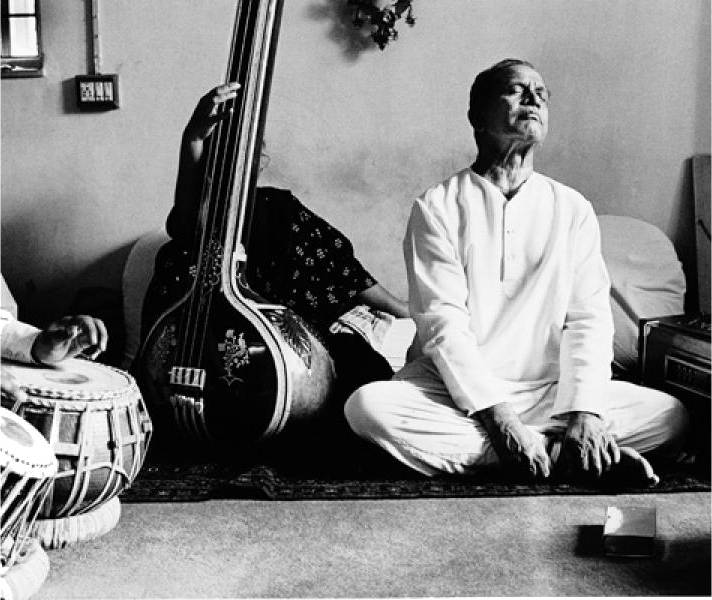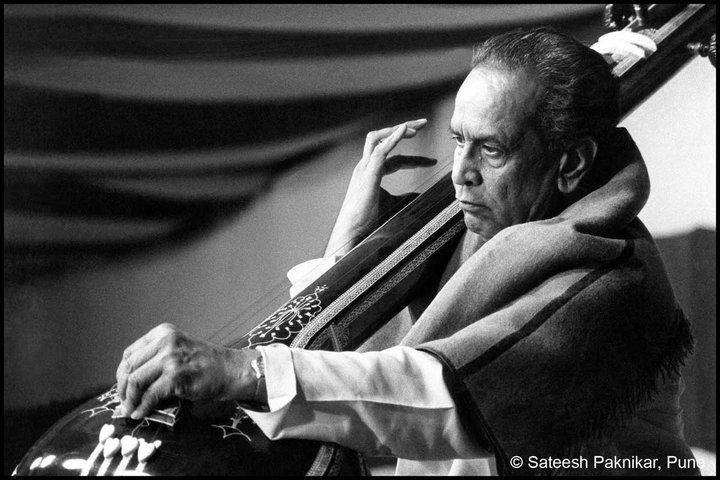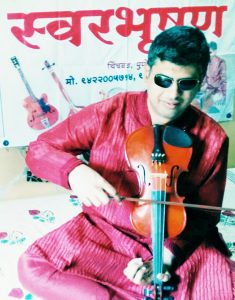Bhushan Toshniwal is a National Level Singer of Hindustani and Carnatic Classical and Semi-classical Music and a Motivational Speaker performing all over India. He is a graded artist of All-India Radio and Doordarshan. Has come first all over India in Sangeet Alankar all over India.
To any student of Indian classical music, the name PT Bhimsen Joshi is known right from the beginning of his musical journey. Such was the influence of this legend on our music that, musicians across all Gharanas tried to imbibe something or the other from his music into their style.
Beginners take inspiration from his herculean efforts to learn music, while those who are concert artists, marvel at his immaculate presentation of an ideal music concert, with unsurpassed consistency. Some get enthralled by his long clear ultra-fast taans with effective use of voice dynamics, while some get mesmerized by his melodious alaps.
A spiritual seeker gets connected to God through his devotional Bhajans/Abhangs, while a youngster has tears in his eyes when he listens to his “Piyake Milan ke Aas”, or any such Thumri, feeling himself to be the lover who is anxious to meet his be-loved.
Pandit Jasraj says, “Sangeet Samrat Tansen had the patronage of Emperor Akbar, while Bhimsenji has the whole country behind him.” What is it in Pandit Bhimsen Joshi’s music that attracts various kinds of listeners? In this article, I have tried to take a bird’s eye view of this maestro’s musicianship, to find the answer to this question.

Credit - https://bit.ly/3aT7I9x
Powerful yet melodious voice
People always thought that, to sing the style of KiranaGharanaone must have a thin, high-pitch voice. But when we talk of Bhimsenji, the first thing that comes to mind is his powerful voice, which is not the traditional voice for his Gharana.
According to Dr.Wasantrao Deshpande, “Bhimsenji’s voice is completely masculine. Yet it has a lot of emotive appeal.” Bhimsenji showed us that any powerful voice can be extremely melodious, if you can give the correct voice throw for various genres. This voice throw was the result of rigorous Sadhana.
Ganasamradni Lata Mangeshkar, while talking about Panditji says, “I am 75 years old, but am 75 years behind Anna [Bhimsenji] in terms of Sadhana.” Panditji says, “I would do KharajSadhana [lower octave practice] from 4-6 AM. My Guru Sa-vaiGandharva often said that, whatever you sing in the middle octave, [like nyasa, Meends, Gamakasetc] you should be able to do it in the lower octave as well.”
According to my guru Bhajan Samrat Anup Jalotaji, “Bhimsenji’s voice invoked Gambheera Rasa, which has a lot of appeal. Along with his voice, his rigorous Sadhana helped him become the Tansen of the modern era.”. “ His use of voice for singing Khayal, and Thumri would be totally different. Even in Khayals his voice tonality would vary with the Raga bhava. His voice would sound cheerful when he sang ragas like Yaman, ShuddhaKalyan, while for ragas like Darbari Kanada, Malkauns, etc. it would invoke Gambheera Rasa. For ragas like Shankara, Durga, etc. his voice would invoke Veera Rasa. Even in his taans his use of voice dynamics [especially in the higher octave] fascinated the audience.
When asked about how he achieved this, he says, “I used to practice ragas Todi, Multani, and Puriya in morning, afternoon and evening respectively. Until I master one thing- Palta/Tan Pattern, my guru would not be satisfied and would not teach me anything further. He believed that, if you master one thing, you can master all. But if you try to master all at once, you would lose everything.”
His voice would be strong and powerful for Khayal and soft and melodious for Thu-mri/bhavgeet/natyageet etc. Another important thing is this transition in voice throw would occur, the moment he switched over from one genre to another.
Unique style of singing
Even though Panditji belonged to KiranaGharana, he imbibed elements from Jaipur, Gwalior, Agra and other Gharanas to form his own style. He even inculcated some things from Carnatic music and people find a bit of Carnatic as well in his Alaps. He brought more LayaAng in his presentations by introducing Bol Alaps, which would come at the end of an Avartan [while he elaborated a raga in slow speed].
Once a Maestro from Jaipur Gharana said to him, “Your KiranaGharana artists take an eternity to elaborate a raga”, after which Panditji brought the art of compact presentation in his music. His long ultra-fast Taans [which would caste a magical spell on audience], and mastery over various types of Tan patterns was his important contribution to Kirana Gharana, which was otherwise known for its elaborate alaps.
The great playback singer Manna De says, “I happened to sing for a film with Pan-ditji. In one of his Taans, I thought now he would come back to the line of the song at a particular point, but he just carried on for two more avartanas.”Panditji says, “To become a good artist, one must be a good robber of knowledge and aesthetics of others. Wherever I find beauty, I try to imbibe it.”

Credits - https://bit.ly/2Nh2koM
Thoughts on an Ideal Concert
Panditji would often say, “One should be able to sing precisely in a concert. Even if you have 50 Taans in mind you should be able to sing the best among them.” He also warned the upcoming artists about the difference between concert and practise. “Practise implies removing the weaknesses from your voice/singing, and trying to master what you are not good at. While concert is the presentation of what you know best.”
Another thing he focused on is the taste of his audience. “One learns with expe-rience what the audience wants on a given day. Some days, you will have audience which wants more Alaps, while other days, the audience may want more Taans/boltaans. An artist should be able to manage all kinds of audiences.”
Once, Panditji’s concert was arranged at a village. He started with Raga Yaman. However the people were still chatting among themselves. After just 2/3 minutes of Yaman, Panditji started one of his immortal Abhangs, and the audience became silent immediately. Once, the organizers wanted Panditji to have songs from the lighter forms, but Panditji sang Raga Purvi, putting his heart into it, and was highly appreciated.
During his long concert career, Panditji faced many challenging situations. For ex-ample, once he had to sing after Ustad Amir Khan. Ustadji had rendered raga Dar-bari, which was one of his best. Everyone was skeptical as to how Panditji [who was young then] would handle the situation. Panditji hummed something like Darbari, and someone asked him, “Are you also singing Darbari?” to which panditji said, “yes”. All of Panditji’s followers were now afraid. However Panditji showed a different shade of the same raga, and wiped Ustad Amir Khan’s rendition from people’s mind. He had to sing many times after Pandit Ravi Shankar, Pandit Kumar Gandharva etc. in all such situations, his rigorous Sadhana, and his self-confidence helped him.
Panditji believed that an artist must be able to sit for the entire concert duration without changing his position, and then only he will be able to focus on his music. To have this stamina, an artist must have good health. Panditji had a great physique, for which he would swim/do yoga/play hockey or football etc. If any of his disciples tried to change their position, he would ask, “didn’t you have food today?”
I conclude this section with a very important thought by Panditji. “Music changes every ten years. The artist should also change accordingly. In my younger days, concerts started at 10 PM and ended at 6 AM, but in today’s times, an artist must be able to present the Raga in a short time without compromising on its aesthetics.”
Panditji often told his disciples, “You should be able to present the raga for 5 mi-nutes, and also for an hour as well.” Panditji has sung the popular Bhairavi “mile sur meratumhara” [which was used for a project of national integration] for 3 time durations which differed by just a few seconds.
Raga selection
Panditji was often criticised for singing the same ragas time and time again. Panditji answered this in the following manner. “Every gharana/artist has its own set of ragas which he has mastered and which give him pleasure as well. Only thing is that our Kirana Gharana is criticised because where there is sugar, there are ants. Even if I sing Raga Shuddha Kalyan for 2/3 days in a row, you will get a different shade of it every time. A performer should not focus on mere number of ragas, but should focus on how to aesthetically innovate more and more in a raga, and enrich his musicianship.One must understand that, in one life, we can master only 25-30 ragas.”
Having said this, Panditji did not stick to ragas rendered only by KiranaGharana artists, [Marwa, Puriyadhanashri, MiyanMalhar, Bhimpalas etc] but also rendered ragas from other Gharanas such as Komal Rishabh Asawari, Yamani Bilaval, Chaya Malhar, Gaud Sarang, Jayjayvanti, etc. He also tried some jod ragas such as Bageshwari Bahar, Hindolita, Lalat Bhatiyar, Marwashri, etc.
One of Panditji’s own creation was a Jod raga called Kalashri, which is a combi-nation of Kalavati and Rageshri.
Panditji says, “When you sing a jod raga, both the ragas should be sung in ap-proximately equal proportion, and should be mixed effectively. For example if you are singing kafikanada, you should not sing kafi for 75 % and sing Kanada at the end, as if you have remembered it just then.”
Devotional and other forms of music
Panditji tried his hand at various other forms of music such as devotional songs, bhavgeet, film songs etc. His devotional songs in Marathi, Hindi and Kannada earned him mass popularity. While singing these songs, he worked with many music directors from these languages. He says, “It is the duty of the singer to understand the full meaning and be one with the Bhava of the song. Then he can sing for anyone.” Panditji also did many jugalbandis with the Carnatic music maestro Dr. M Balamurali Krishna, through which he made an effort to bridge the gap between Carnatic and Hindustani music. He even sang for an English film with Pandit Jasraj. One of his famous albums is Ram Shyam Gun Gan, which he sang with Bharat Ratna Lata Mangeshkar.
Conclusion
Bhimsenji’s powerful voice, his skill to cater to all kinds of audiences, his non-conformist attitude, his ability to handle various forms of music, helped him to become one of the most successful exponents of Indian classical music.
According to my Guru Sangeet Samrat Chitravina N Ravikiran, “Pt Bhimsen Joshi ji was indisputably one of the most mammoth vocalists our country has produced. His towering voice, the musical force, the con-viction in delivery, technical excellence and overall aesthetic percep-tivity are the biggest testimony to his pedigree, practice and intros-pection. His legacy is something all music lovers would cherish and artists would love to match.”
Bharat Ratna Swarabhaskar Pandit Bhimsen Joshi will be remembered forever through his divine music.



